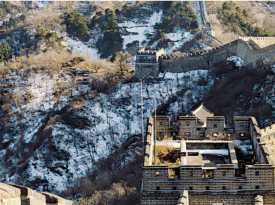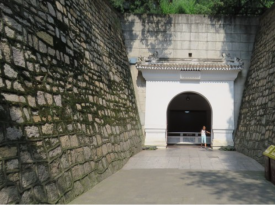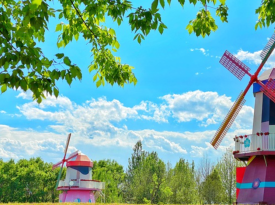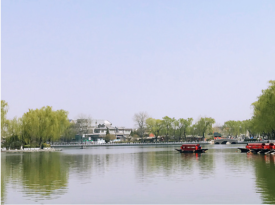The Forbidden City
The Forbidden City, formerly known as the Purple Forbidden City, is a magnificent palace complex that bears hundreds of years of history and culture, occupying a pivotal position in the history of architecture both in China and around the world.
- Scale of the Architecture and Completeness of Preservation
It is the most complete and largest ancient architectural complex with wooden structures in China and even in the world. The entire Forbidden City covers an area of approximately 720,000 square meters, with a building area of about 150,000 square meters. It has more than seventy palaces of various sizes and over nine thousand rooms. Its architectural layout is rigorous, centered around the Three Great Halls (the Hall of Supreme Harmony, the Hall of Central Harmony, and the Hall of Preserving Harmony). These three halls are located on the central axis of the Forbidden City, presenting a magnificent spectacle. The Hall of Supreme Harmony is the largest and highest-ranked building in the Forbidden City. It adopts the architectural form of a double-eaved hip-and-gable roof, decorated with gold dragon and phoenix designs in polychrome painting, looking resplendent and magnificent. The marble terrace in front of the hall is exquisitely carved, demonstrating the majesty of the imperial family. The Hall of Central Harmony is the place where the emperor takes a rest before holding grand ceremonies in the Hall of Supreme Harmony. The Hall of Preserving Harmony is used for the final imperial examinations and important events such as banquets for princes and nobles. Whether in terms of architectural craftsmanship or the selection of building materials, these buildings are masterpieces of ancient architectural art. Having endured hundreds of years of wind and rain, wars, and other hardships, they are still so well-preserved that they are truly gems in human cultural heritage. Therefore, it is hailed as the "top of the Five Great Palaces in the world". The other four palaces include the Palace of Versailles in France, Buckingham Palace in Britain, the White House in the United States, and the Kremlin in Russia. However, the Forbidden City stands out with its unique charm of oriental architecture and profound cultural heritage.

- Layout and Functions of the Inner Court
The Inner Court is centered around the three rear palaces, namely the Qianqing Palace, the Jiaotai Palace, and the Kuning Palace, along with the East Six Palaces on the east side and the West Six Palaces on the west side. It was the residence of feudal emperors and their concubines, commonly known as the "Three Palaces and Six Courtyards". The Qianqing Palace is the emperor's sleeping quarters. The building is tall and magnificent. In the center of the hall, there is a gilded carved dragon throne, with the plaque of "Upright and Bright" hanging high above. It was an important place where emperors of the Ming and Qing dynasties handled daily government affairs, read and approved memorials, and summoned officials. At the same time, it was also the place where the emperor lived and rested, playing a crucial role in court life. The Jiaotai Palace is located between the Qianqing Palace and the Kuning Palace. It is the place where the empress received congratulations on her birthday. The hall preserves important cultural relics such as the imperial seals of ancient emperors. The Kuning Palace was the empress's sleeping quarters in the Ming Dynasty. In the Qing Dynasty, its functions changed somewhat, with part of it being transformed into a place for Shamanist worship. The East Six Palaces and the West Six Palaces were the residences of the imperial concubines. Each palace has its own name and unique architectural style. The layout of these palaces is regular, and the environment is quiet and secluded, witnessing the joys and sorrows of countless court women. The East Six Palaces include the Jingren Palace, the Chengqian Palace, the Zhongcui Palace, the Yanyu Palace, the Yonghe Palace, and the Jingyang Palace. The West Six Palaces include the Yongshou Palace, the Yikun Palace, the Chuxiu Palace, the Qixiang Palace, the Changchun Palace, and the Xianfu Palace. The architectural decorations of these palaces are exquisite, with beautiful murals, gorgeous doors and windows, and delicate wood carvings, reflecting the luxurious life of the ancient imperial family.
- Treasures and Cultural Relics
There are a large number of precious cultural relics treasured in the Forbidden City. According to statistics, there are millions of them, accounting for one-sixth of the total number of cultural relics in the country. These cultural relics cover various fields and are of diverse types. There are calligraphy and painting works, such as "Ode to the Nymph of the Luo River" by Gu Kaizhi of the Eastern Jin Dynasty (a Song Dynasty copy), "The Emperor Receiving an Audience" by Yan Liben of the Tang Dynasty, and "Along the River During the Qingming Festival" by Zhang Zeduan of the Song Dynasty. These calligraphy and painting works are the pinnacle of ancient Chinese painting art, possessing extremely high artistic and historical values. There are also ceramic works, ranging from simple and primitive pottery to the exquisite official kiln porcelain of the Ming and Qing dynasties, showing the development process of Chinese ceramic technology over thousands of years. For example, the porcelain of the five famous kilns in the Song Dynasty, namely Ru Kiln, Guan Kiln, Ge Kiln, Jun Kiln, and Ding Kiln, has elegant shapes and smooth glazes, and each piece is a rare treasure. In addition, there are bronze wares, jade wares, ancient books and documents, clocks and watches, jewels, etc. Among the bronze wares, there are many important vessels from the Shang and Zhou dynasties, and the inscriptions on them provide important materials for studying ancient history and culture. The jade wares include beautiful jade pendants and jade ornaments, reflecting the superb jade carving technology in ancient times. The ancient books and documents include a large number of rare copies and fine editions, which are indispensable for studying ancient Chinese culture, thought, and history. The clocks and watches collected in the Forbidden City are mostly those presented by foreign countries or made by the court itself during the Ming and Qing dynasties. They have unique shapes and exquisite craftsmanship, and some clocks and watches also have complex mechanical devices and performance functions. The jewelries include various gold and silver ornaments and gemstone products, which are exquisitely made and magnificent. These cultural relics are not only the crystallization of art but also the witnesses of the history and culture of the Chinese nation, making the Forbidden City a veritable cultural treasure house.

- Visiting Routes and Precautions
The Forbidden City should be visited from south to north. The Meridian Gate is the only entrance, and the exits are the Donghua Gate and the Shenwu Gate. After entering through the Meridian Gate, visitors embark on a cultural journey through time and space. Walking along the central axis, they can visit important buildings such as the Three Great Halls one by one and appreciate the majestic aura of the imperial palace. During the visit, it is recommended that visitors follow the signs and guided routes so as to better understand the history and cultural connotations of the Forbidden City. Meanwhile, in order to protect the cultural relics and ancient buildings, visitors need to abide by the relevant regulations of the Forbidden City, such as not touching the cultural relics and ancient buildings and not smoking in the palaces. Since the Forbidden City has a large area and the visiting time may be long, visitors can arrange their time reasonably and take appropriate breaks during the visit.
- The Beauty of the Forbidden City in Different Seasons - Taking Late Spring and Early Summer as an Example
In the late spring and early summer, the Forbidden City presents a unique and beautiful scene. At this time, the pear trees in the Forbidden City are in full bloom. Clusters of pure white pear blossoms, like clouds and snow, form an interesting contrast with the red bricks and green tiles of the Forbidden City. The pure white pear blossoms and the red palace walls set off each other, creating a distinct yet harmonious color contrast. When the breeze blows, the pear blossoms flutter down like snowflakes, scattering on the ancient stone paths and in the corners of the palaces, adding a touch of liveliness and poetry to this ancient and solemn palace. Besides the pear blossoms, other flowers, plants, and trees in the Forbidden City also show vigorous vitality in this season. The tender green leaves and the ancient buildings are intertwined, as if telling the stories of the years. Visitors strolling among them can feel the weight of history and appreciate the unique charm bestowed upon the Forbidden City by nature. The perfect combination of natural beauty and humanistic beauty makes the Forbidden City exude unique charm in different seasons, attracting countless visitors to come and admire it.
TAG:




